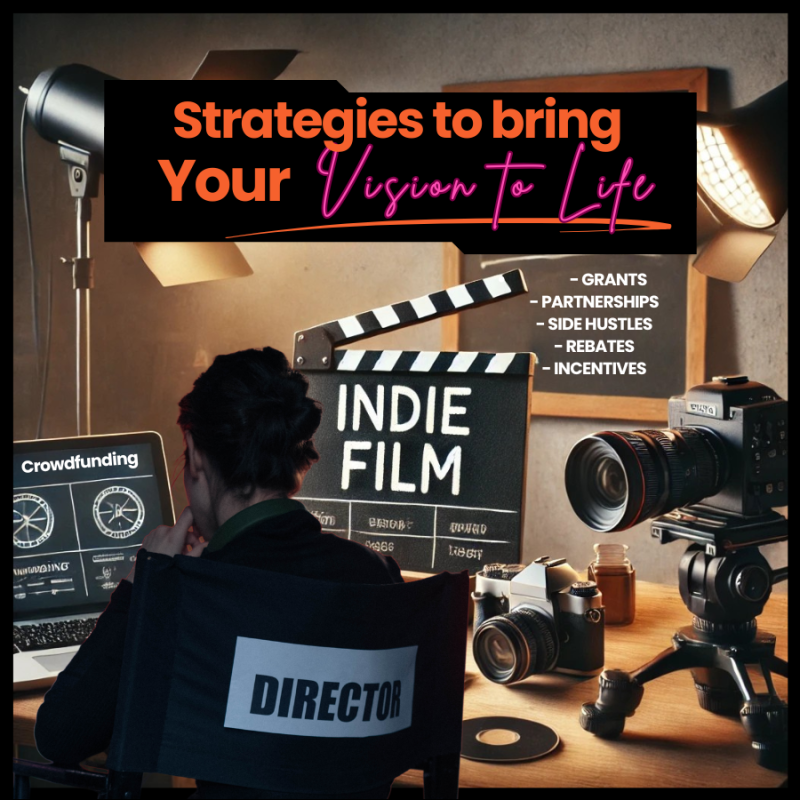Indie filmmaking thrives on creativity and resourcefulness. While big-budget studios might have endless resources, indie filmmakers often face the challenge of funding their projects on a limited budget. The good news? You don’t need millions to bring your vision to life. By leveraging innovative funding strategies, cutting costs, and tapping into supportive communities, you can fund your indie film without breaking the bank.
1. Crowdfunding: The Power of Community Support
Crowdfunding platforms like Kickstarter, Indiegogo, and Seed&Spark have revolutionized the way indie filmmakers secure funding.
- Build a Strong Campaign: Clearly articulate your project’s vision, goals, and how contributions will be used. Use compelling visuals and a teaser trailer to capture attention.
- Engage Your Audience: Offer enticing perks, such as exclusive behind-the-scenes access, personalized thank-you notes, or film credits.
- Promote Strategically: Leverage social media and email newsletters to spread the word about your campaign. Collaborate with influencers or industry peers to amplify your reach.
Example: The film The Babadook raised over $30,000 on Kickstarter, which became the foundation for its critically acclaimed success.
2. Grants and Fellowships: Free Money for Filmmakers
Numerous organizations offer grants and fellowships specifically for indie filmmakers.
- Research Opportunities: Look into grants such as the Sundance Documentary Fund, Cinematography Grants by Panavision, or regional arts councils.
- Tailor Your Application: Customize each grant application to highlight how your project aligns with the funder’s mission.
- Deadlines Matter: Keep a calendar of submission dates to ensure you never miss an opportunity.
Pro Tip: Many grants focus on underrepresented voices in film—if your project highlights unique perspectives, make this a focal point.
3. Partnerships and Sponsorships: Win-Win Collaborations
Brands and local businesses can be excellent partners in funding your film.
- Product Placement: Offer on-screen placement of a brand’s products in exchange for financial support.
- Mutual Benefits: Highlight how sponsoring your film can increase their visibility or align with their values.
- Local Support: Small businesses may be more willing to contribute in exchange for credits or promotional opportunities within their communities.
Example: Tangerine, an indie hit, partnered with a local business for shooting locations and funding.
4. Personal Savings and Side Hustles: A Steady Foundation
While external funding is invaluable, starting with personal contributions can demonstrate your commitment to potential investors.
- Set a Budget: Allocate a specific portion of your savings toward essential costs like equipment and permits.
- Freelance Opportunities: Consider taking on gigs like videography, editing, or scriptwriting to build funds.
- Smart Investments: Purchase versatile equipment that can be reused across multiple projects, reducing future costs.
5. Film Collectives and Co-Productions: Strength in Numbers
Joining forces with other filmmakers or production companies can help alleviate financial burdens.
- Share Resources: Pool equipment, locations, and crew members to cut down on costs.
- Collaborative Grants: Some grants reward co-productions or projects involving multiple creative teams.
- Skill Exchange: Trade your expertise in one area (e.g., editing) for help in another (e.g., cinematography).
6. Tax Incentives and Rebates: Location, Location, Location
Many states and countries offer tax incentives to filmmakers shooting in their jurisdictions.
- Research Eligibility: Look into areas with filmmaker-friendly incentives, such as New Mexico or Georgia in the U.S.
- Local Film Commissions: Reach out to film offices to understand rebate structures and submission requirements.
- Plan Strategically: Incorporate these savings into your initial budget to reduce financial stress.
7. Micro-Budget Strategies: Stretching Every Dollar
Mastering micro-budget filmmaking ensures that every dollar is used wisely.
- Embrace Minimalism: Use minimal locations, a small cast, and practical effects.
- DIY Mentality: Handle tasks like editing, set design, or costume creation yourself or with your team.
- Community Resources: Borrow props, scout free locations, and seek in-kind contributions from local supporters.
Pro Tip: Films like Paranormal Activity prove that creativity often matters more than money when it comes to storytelling.
8. Networking and Industry Events: Building Relationships That Pay Off
Attending film festivals, workshops, and industry events can open doors to unexpected funding opportunities.
- Pitch Your Project: Use networking opportunities to present your film idea to potential investors or collaborators.
- Learn from Experts: Gain insights on funding and distribution strategies from experienced filmmakers and industry professionals.
- Form Alliances: Building relationships with like-minded creatives can lead to shared resources or joint projects.
Example: Many filmmakers have secured funding through connections made at festivals like Sundance or Cannes.
9. Social Media Campaigns: Harnessing Digital Power
Social media is a powerful tool for rallying support and attracting backers.
- Engage Consistently: Share updates, behind-the-scenes content, and progress to keep your audience invested.
- Use Hashtags: Increase visibility by using trending and niche hashtags related to indie filmmaking.
- Collaborate with Influencers: Partner with social media personalities who align with your film’s theme to reach a broader audience.
Shoot Big, Spend Small
Your Guide to Micro-Budget Filmmaking
Think you need a massive budget to make a powerful indie film? Think again. Our Micro-Budget Filmmaking guide is packed with practical tools, tips, and must-have gear to help you shoot smarter—not pricier.

- Discover budget-friendly equipment that delivers cinematic results.
- Learn to stretch your resources without compromising your vision.
- Master DIY hacks used by successful indie filmmakers worldwide.
Whether you’re working with a shoestring budget or just love being resourceful, this free guide helps you maximize every dollar while staying creative and in control.
🎥 Ready to create more with less?
👉 Explore the Micro-Budget Filmmaking Kit
Keep leveling up your craft—dive into more tips and strategies across our filmmaking blog.


1 thought on “From Concept to Completion: How to Fund Your Indie Film Without Breaking the Bank”
Pingback: How to Use Low-Cost Filmmaking Tools for High-Quality Indie Films